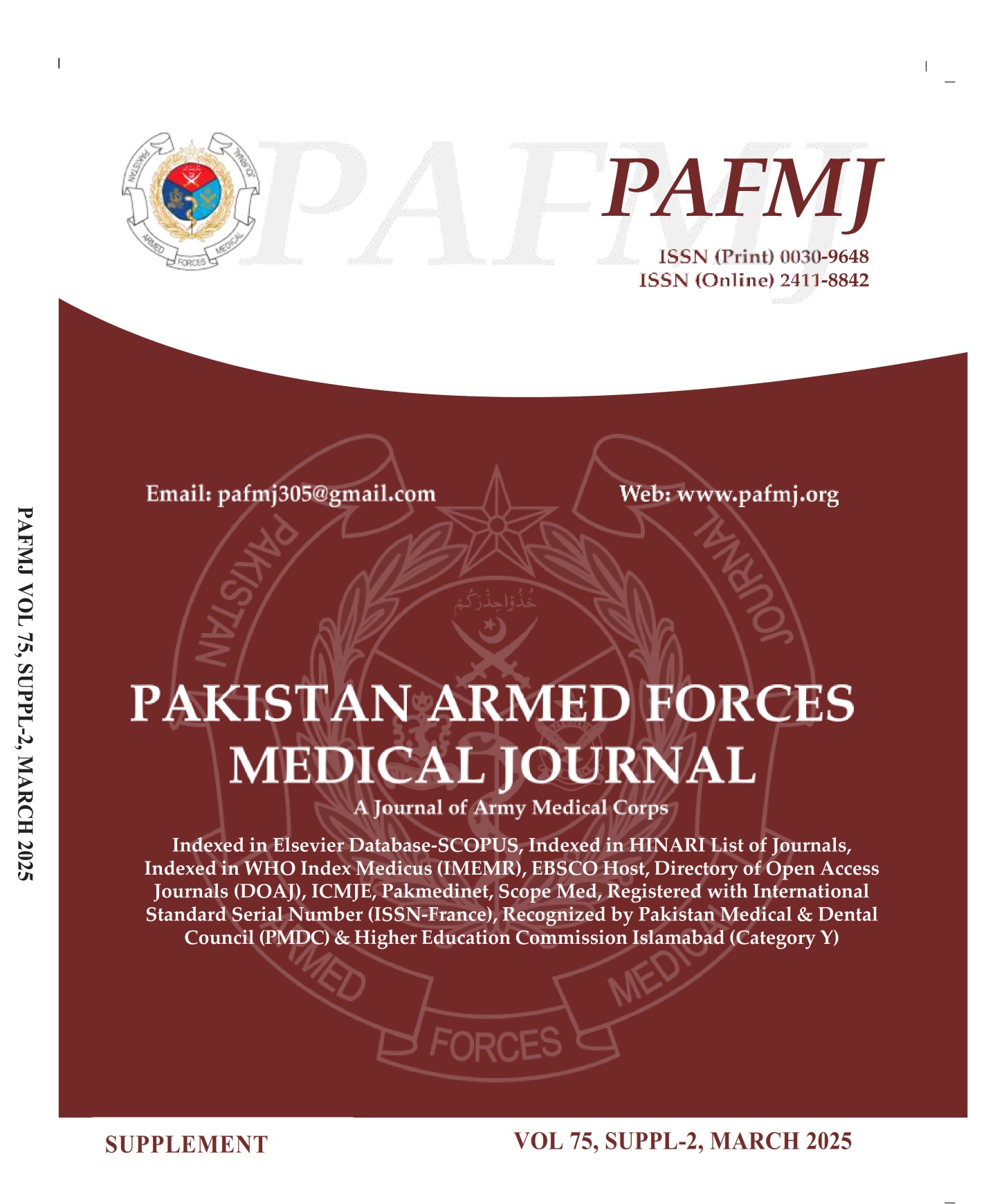Brachio-Cephalic AVF as a Preferred Autogenous Hemodialysis Access in Elderly Chronic Kidney Disease Patients
DOI:
https://doi.org/10.51253/pafmj.v75iSUPPL-2.6975Keywords:
Elderly, Hemodialysis, Primary Patency, Vascular AccessAbstract
Objective: To identify the preferred method of primary autogenous hemodialysis vascular access in elderly patients with End Stage Kidney Disease.
Study Design: Prospective comparative study
Place and Duration of Study: Department of vascular surgery, Combined Military Hospital, Rawalpindi Pakistan, from June 2020 to May 2021.
Methodology: Outcomes of the patients with Radiocephalic (RCAVF) and Brachiocephalic (BCAVF) Arteriovenous fistula were analyzed, undergoing a first surgical vascular access procedure for hemodialysis (HD). We examined the effect of age and other factors including sex, diabetes mellitus and preoperative duplex ultrasound imaging on AVF maturity and primary patency.
Results: We recruited 460 patients who underwent Radiocephalic (RCAVF) and Brachio-Cephalic AVF (BCAVF) primary HD vascular access procedure. The mean maturity time in RCAVF group was 8.30±2.3 weeks while in the BCAVF group was 4.60±2.2 weeks and result was statistically significant (p<0.001). Primary Patency at 6 months was 59.9% in RCAVF group while 85.7% in the BCAVF group, the chi square test result showed statistical significance (<0.001). Likewise mean Operative Time in RCAVF group was 70.26±1.48 minutes while in the BCAVF group was 50.01±1.52 minutes and the result of independent sample t test showed statistical significance. Patient survival in our study was 86.0% at 12 months.
Conclusion: Brachiocephalic AVFs is feasible choice, as hemodialysis vascular access in Elderly CKD patients in terms of Maturity, Primary patency and mean operative time as compared to forearm Radiocephalic AVFs.
Downloads
References
Imran S, Sheikh A, Saeed Z, Khan SA, Malik AO, Patel J, et al. Burden of chronic kidney disease in an urban city of Pakistan, a cross-sectional study. J Pak Med Assoc 2015; 65(4): 366.
Jessani S, Bux R, Jafar TH. Prevalence, determinants, and management of chronic kidney disease in Karachi, Pakistan - a community based cross-sectional study. BMC Nephrol 2014; 15: 90.
Ullah K, Butt G, Masroor I, Kanwal K, Kifayat F. Epidemiology of chronic kidney disease in a Pakistani population.
Saudi J Kidney Dis Transpl 2015: 26: 1307-1310.
Viecelli AK, Charmaine E, Hemodialysis vascular access in the elderly—getting it right. Kidney Int 2019; 95: 38–49.
Moist LM, Lok CE, Vachharajani TJ, Xi W, AlJaishi A, Polkinghorne KR, et al. Optimal hemodialysis vascular access in the elderly patient. Semin Dial 2012; 25(6): 640-8.
https://doi: 10.1111/sdi.12037
Jin DC, Yun SR, Lee SW, Han SW, Kim W, Park J, et al. Current characteristics of dialysis therapy in Korea: 2016 registry data focusing on diabetic patients. Kidney Res Clin Pract 2018; 37: 20–29. https://doi: 10.23876/j.krcp.2018.37.1.20
Dhingra RK, Young EW, Hulbert-Shearon TE, Leavey SF, Port FK. Type of vascular access and mortality in US hemodialysis patients. Kidney Int 2001; 60: 1443–1451.
https://doi: 10.1046/j.1523-1755.2001.00947.x
Bae E, Lee H, Kim DK, Oh KH, Kim YS, Ahn C, et al. Autologous arteriovenous fistula is associated with superior outcomes in elderly hemodialysis patients. BMC Nephrol 2018; 19(1): 306. https://doi: 10.1186/s12882-018-1109-9
Niyyar VD, Haimanot W. Vascular Mapping: Does It Help To Maximize Fistulae Placement? Adv Chronic Kidney Dis 2009; 16(5): 316-320.
Arhuidese IJ, Cooper MA, Rizwan M, Nejim B, Malas MB. Vascular access for hemodialysis in the elderly. J Vasc Surg 2019; 69(2): 517-525.e1.
https://doi: 10.1016/j.jvs.2018.05.219
Dageforde LA, Kelly A, Irene D,Shaffer D, Increased Minimum Vein Diameter on Preoperative Mapping with Duplex Ultrasound is Associated with Arteriovenous Fistula Maturation and Secondary Patency, J Vasc Surg 2015 ; 61(1): 170-176
Jeong S, Kwon H, Chang JW, Kim MJ, Ganbold K.Effects of Patient Age on Patency of Chronic Hemodialysis Vascular Access, BMC Nephrol 2019; 20(1): 422.
Woodside KJ, Repeck KJ, Mukhopadhyay P, Schaubel DE, Shahinian VB, Saran R, et al. Arteriovenous Vascular Access-Related Procedural Burden Among Incident Hemodialysis Patients in the United States. Am J Kidney Dis 2021; 78(3): 369-379.e1.
https://doi: 10.1053/j.ajkd.2021.01.019
Disbrow DE, Cull DL, Carsten CG , Yang SK, Johnson BL, Keahey GP. Comparison of arteriovenous fistulas and arteriovenous grafts in patients with favorable vascular anatomy and equivalent access to health care: is a reappraisal of the Fistula First Initiative indicated? J Am Coll Surg 2013; 216(4): 679-685; discussion 685-6.
https://doi: 10.1016/j.jamcollsurg.2012.12.021
Vrakas G, Defigueiredo F, Turner S, Jones C, Taylor J, Calder F. A comparison of the outcomes of one-stage and two-stage brachiobasilic arteriovenous fistulas. J Vasc Surg 2013; 58(5): 1300-1304.
https://doi: 10.1016/j.jvs.2013.05.030
Georgiadis GS, Charalampidis DG, Argyriou C, Georgakarakos EI, Lazarides MK. The Necessity for Routine Pre-operative Ultrasound Mapping Before Arteriovenous Fistula Creation: A Meta-analysis. Eur J Vasc Endovasc Surg 2015; 49(5): 600-605.
https://doi: 10.1016/j.ejvs.2015.01.012
Keagy BA. Vascular surgery training after primary certification: where we go from here. Semin Vasc Surg 2006; 19(4): 222-228. https://doi: 10.1053/j.semvascsurg.2006.08.012
Kahraman N, Demir D. Outcomes of arteriovenous fistula reconstruction in vascular access dysfunction. Am J Tranl Res 2019; 11(2): 1058-1065
Kucey AS, Joyce DP, O-Neill T, Fulton GJ, Plant WD, Manning BJ. Patients referred for arteriovenous fistula construction: a retrospective outcome analysis. Ir J Med Sci 2020; 189(2): 658-691.
Downloads
Published
Issue
Section
License
Copyright (c) 2025 Muhammad Afzal Randhawa, Muhammad Jamil, Khurram Shoaib Khan, Muhammad Irfan, Ruqia Begum, Tahir Mehmood Butt

This work is licensed under a Creative Commons Attribution-NonCommercial 4.0 International License.















